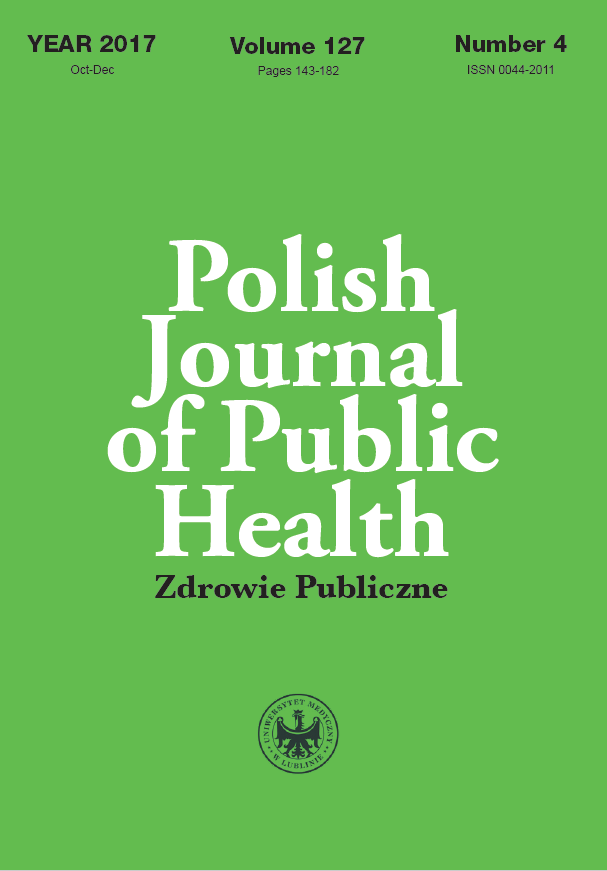Analysis of the effectiveness concerning initiatives for pedestrians’ safety on roads: a questionnaire survey
DOI:
https://doi.org/10.1515/pjph-2017-0035Keywords:
road safety, social campaigns, students’ opinions, pro-health behaviourAbstract
Introduction. One of the most important issues and challenges of public safety policy in highly developed countries is the problem of ensuring road safety, along with dealing with health and material losses resulted from accidents. Unfortunately, Poland, in comparison to other EU countries, has one of the worst statistics regarding accidents and mortality ratios, therefore it is essential to undertake long-term actions aimed at improving road safety, as well as educating drivers and pedestrians.
Aim. The purpose of this study is to analyse the problem and to investigate whether traffic safety campaigns are effective, and if they reach young audience.
Material and methods. The research was conducted in the first quarter of 2018 among the students of Faculty of Health Sciences of the Medical University of Lublin. The study method applied was a diagnostic survey, and the tool was an original questionnaire. The participation was voluntary and anonymous. The obtained results were the subject of later statistical analysis. As many as 153 young respondents aged between 18 and 25 were tested, out of whom 73.68% were women and 26.32% were men.
Results. Over half of the surveyed (56.3%) declared walking as the main form of participation in traffic, and 25.9% of the surveyed used public transport. The most numerous group of the examined (34.21%) thought that the Polish roads were rather unsafe. As the reasons for the low safety on the Polish roads the respondents identified: bad condition of the roads (69.1%), drivers’ recklessness (67.1%), and maladjustment of the driving style to weather conditions (60.5%). All respondents have encountered campaigns concerning road safety, however not too often (56.58% less than once a month). The surveyed encountered these social campaigns on TV (88.2%), on the Internet (54.6%), and on billboards (23.7%).
Conclusion. Promotional campaigns concerning road safety have a greater impact on women. In the examined group, around 67% of women changed their behaviour as a result of the campaigns, and only 42.5% of men. Social campaign which was best remembered, and had the biggest influence on the respondents (50.3%) was „Say STOP to reckless driver you love”.
References
1. Komenda Główna Policji, Wypadki drogowe w Polsce w 2017 r., Warszawa; 2018.
2. ITF, Road Safety Annual Report 2017.Paris: OECD Publishing; 2017.
3. Raczyńska-Buława E. Bezpieczeństwo w ruchu drogowym w Europie – założenia polityki UE i ocena podejmowanych działań z perspektywy danych statystycznych. Autobusy TEST. 2016;10:8.
4. Płachecka M. Efekty działań na rzecz poprawy bezpieczeństwa w transporcie publicznym w Polsce. Autobusy TEST. 2016;10:23.
5. Tokarczyk E. Kampanie społeczne w systemie działań na rzecz bezpieczeństwa ruchu drogowego. Autobusy TEST. 2013;3:514.
6. Phillips RO, Ulleberg P, Vaa T. Meta-analysis of the effect of road safety campaigns on accidents. Accid Anal Prev. 2011;43(3):1204-18.
7. Hoekstra T, Wegman F. Improving the effectiveness of road safety campaigns: Current and new practices. IATSS Res. 2011;34(2):80-6.
8. Lakshmi R, Boramma G, Ghooli, S. A study to assess the knowledge and practice of road safety measures among undergraduate medical students of M. R. Medical College, Kalaburagi. IJCMPHI. 2018;5(4):1596-601.
9. Özkan T, Lajunen T. What causes the differences in driving between young men and women? The effects of gender roles and sex on young drivers’ driving behaviour and self-assessment of skills. TRANSPORT RES FTRAF. 2006;9(4):269-77.
10. Özkan, T, Lajunen T. Why are there sex differences in risky driving? The relationship between sex and gender- role on aggressive driving, traffic offences, and accident involvement among young turkish drivers. Aggr Behav. 2005;31:547-58.
11. Krajowa Rada Bezpieczeństwa Ruchu Drogowego, Raport: Stan bezpieczeństwa ruchu drogowego oraz działania podejmowane w tym zakresie w 2016 r. Warszawa; 2017.
12. Badanie efektywności kampanii społecznej dotyczącej profilaktyki zakażeń HIV/AIDS przeprowadzonej na zlecenie Krajowego Centrum ds. AIDS. TNS OBOP; 2012.
13. Kucewicz AM. Kampanie na temat bezpieczeństwa drogowego w Polsce na tle doświadczeń brytyjskich. In: B. Jacennik. Komunikowanie społeczne w promocji i ochronie zdrowia. Warszawa: Vizja Press⁢ 2010. p. 31-52.
14. [kampaniespoleczne.pl]
15. Sarbinowska J, Jędrzejek M, Synowiec-Piłat M. Idea of empowerment for health based on selected European social campaigns. Hyg Pub Health. 2013;48(4):424-31.
16. Piekutowska S, Kanicka M, Pogorzelska P, et al.Role of social campaigns in promoting health behavior among college students in Bialystok. Hyg Pub Health. 2013;48(4):500-4.
Downloads
Published
Issue
Section
License
Copyright (c) 2018 Polish Journal of Public Health

This work is licensed under a Creative Commons Attribution-NonCommercial-NoDerivatives 3.0 Unported License.


